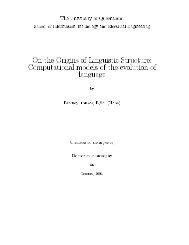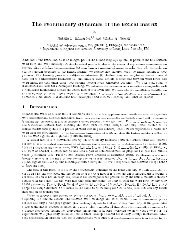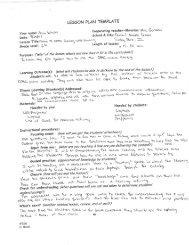Planning and Managing an Exhibition Programme
Planning and Managing an Exhibition Programme
Planning and Managing an Exhibition Programme
Create successful ePaper yourself
Turn your PDF publications into a flip-book with our unique Google optimized e-Paper software.
) Products<br />
blished by<br />
audio <strong><strong>an</strong>d</strong><br />
orm<strong>an</strong>ces,<br />
e museum<br />
promoted<br />
rositioning<br />
,on-related<br />
:h ongoing<br />
lommittee.<br />
'al interior,<br />
all that the<br />
:ollections.<br />
:ultural <strong><strong>an</strong>d</strong><br />
rxPeriences<br />
rs designed<br />
lounders in<br />
cabinets of<br />
ry, enabling<br />
nonstrating<br />
rdia Marine<br />
nquets <strong><strong>an</strong>d</strong><br />
lrved as the<br />
:ures, world<br />
Marine Hall<br />
'alues.<br />
€ople', <strong><strong>an</strong>d</strong><br />
:hat tied the<br />
the maker's<br />
ional obiect.<br />
rrld <strong><strong>an</strong>d</strong> into<br />
. Each act of<br />
>y discovery.<br />
rrney guided<br />
ors brought<br />
ty of hum<strong>an</strong><br />
acticallY. The<br />
; reflected in<br />
the skill <strong><strong>an</strong>d</strong> originality with which the work was executed; to look for clues of place <strong><strong>an</strong>d</strong> time<br />
reflected in the style <strong><strong>an</strong>d</strong> medium; to look for a spiritual or metaphysical viewpoint reflected<br />
in the culture <strong><strong>an</strong>d</strong> in the purpose for which the work was intended. Unique groupings,<br />
arr<strong>an</strong>gements <strong><strong>an</strong>d</strong> juxtapositions of objects, as well as the text labeling identifying objects,<br />
were all designed to subtly stimulate awareness of the myriad interconnections among the<br />
works.<br />
This m<strong><strong>an</strong>d</strong>ated a new approach to the selection <strong><strong>an</strong>d</strong> display of collections which is illustrated<br />
in this example from 'Encountering Place', a thematic area that included l<strong><strong>an</strong>d</strong>scapes <strong><strong>an</strong>d</strong><br />
depictions of the natural world,which allowed visitors to consider place <strong><strong>an</strong>d</strong> to try to discover<br />
the artisr's view of the l<strong><strong>an</strong>d</strong>scape. Two paintings juxtaposed on a single wall were a 1795 oil<br />
by Dutch artist Fr<strong>an</strong>z Balthazar Solvyns, Lounching of Gabriel GIIete\ Armed Merchontmon,<strong><strong>an</strong>d</strong><br />
contemporary native Americ<strong>an</strong> artist David Bradley's lndion CountryTodoy.The former is a<br />
shorefront scene in colonial Calcutta showing a ship launching attended by a great multitude,<br />
but with the Europe<strong>an</strong> shipt owner <strong><strong>an</strong>d</strong> a few upper-class lndi<strong>an</strong>s set apart. The latter, a<br />
contemporary Americ<strong>an</strong> painting is of a southwestern Pueblo viewed from above showing a<br />
sacred d<strong>an</strong>ce performed within the Pueblo while mining, gaming, military m<strong>an</strong>oeuvres <strong><strong>an</strong>d</strong><br />
other encroachments threaten from outsideJhe visitor c<strong>an</strong> make comparisons at m<strong>an</strong>y levels.<br />
They are both visually striking works <strong><strong>an</strong>d</strong> superbly executed.They both convey a very still,<br />
quiet, peaceful overall atmosphere,yet they show loci of concentrated activity within them.<br />
They are both about'lndi<strong>an</strong>s', <strong><strong>an</strong>d</strong> c<strong>an</strong> be interpreted as statements about colonialism <strong><strong>an</strong>d</strong><br />
dominadon, each from its artist! own point of view. Yet, the paintings interact <strong><strong>an</strong>d</strong> influence<br />
each other both visually, by virtue of domin<strong>an</strong>t yellows in each palette, <strong><strong>an</strong>d</strong> intellectually; for<br />
example, the overt satire <strong><strong>an</strong>d</strong> pessimism expressed in Indion CountyTodoy c<strong>an</strong> be tr<strong>an</strong>sposed<br />
to the Solvyns painting where it would not have existed if viewed by itself.The Solvyns is also<br />
a self-portrait, which bridges into the self-portraiture theme developed in the next section<br />
of the exhibition,'Encountering People'.<br />
NEWTECHNOLOGIES<br />
A central objective of Odyssey was to create stimulating educational <strong><strong>an</strong>d</strong> recreational<br />
experiences thatwere multi-sensory <strong><strong>an</strong>d</strong> provocative.To achieve it,audio,video <strong><strong>an</strong>d</strong> interactive<br />
media were extensively used in the exhibition, marking a dramatic departure from previous<br />
Peabody Essex Museum exhibitions.There follow some examples:<br />
o<br />
r<br />
Multiple media components were located in each gallery of the exhibition. A large-screen,<br />
rear projection DVD theatre was located just before the entry into East. India Marine<br />
Hall.A four-minute introductory video presented a fast-paced series of <strong>an</strong>imated images<br />
<strong><strong>an</strong>d</strong> music selections that introduced the diversiry of the work <strong><strong>an</strong>d</strong> cultures showcased<br />
in Odyssey.Very brief narration introduced the three main sections of the exhibition.<br />
A visual database with a detailed record for each of the 400 works in the exhibition was<br />
developed on CD-ROM for installation on 19 in (48 cm) touch-screen, PC-based kiosks.<br />
Kiosks were installed at various locations in the Odyssey galleries, programmed identically<br />
to allow visitors in <strong>an</strong>y gallery to navigate through the entire exhibition virtually, in search<br />
of detailed information on <strong>an</strong>y work.The individual object screens included at least one<br />
large image of the work <strong><strong>an</strong>d</strong> extensive textual information. ln m<strong>an</strong>y cases,additional views<br />
PLANNING AND MANAGING AN EXHIBITION PROGMMME 273







